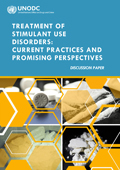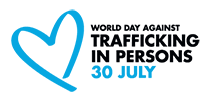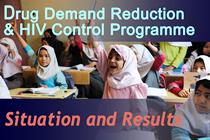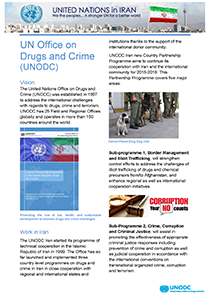Regional Programme for Afghanistan and Neighbouring Countries
Documents
 |
FAMILY UNITED
Family skills programmes support and strengthen positive age-specific and age-appropriate family functioning. Such evidence-based programmes are effective in preventing substance use, violence and crime and as such support many Sustainable Development Goals (SDGs). Since 2010, Drug Prevention and Health Branch, Prevention Treatment and Rehabilitation Section has been actively promoting and piloting such eveidence-based programmes globally in over 30 low-and middle-income countries. This UNODC experience generated the need for a universal family skills programme tailored for low- and middle-income countries. Most available evidence-based programme aredesigned in more economically advantaged countries. UNODC initially developed a family skills programme called “Strong Families”, which is a “universal” in a “selective” settings (families living in challenged and humanitarian contexts –including the internally displaced, refugees, those in conflict and post conflict situations and in very rural settings).
[Download - En]
 |
TECHNICAL GUIDE:
HIV PREVENTION,TREATMENT, CARE AND SUPPORT FOR EOPLE WHO USE STIMULANT DRUGS
Since the beginning of the HIV epidemic, the focus on HIV prevention, treatment and care among people who use drugs has concentrated on the needs of people who inject drugs, and mainly on those who inject opioids. However, data show that there are HIV-related risks associated with the use of non-injecting stimulant drugs, as well as with the unsafe injection of such drugs, including cocaine, amphetamine-type stimulants (ATS) (excluding MDMA),1 and stimulant new psychoactive substances (NPS). Use of stimulant drugs has also been associated with higher risk of HIV transmission through unsafe sexual behaviours in certain subsets of key populations. The purpose of this publication is to provide guidance on implementing HIV, hepatitis C (HCV) and hepatitis B (HBV) programmes for people who use stimulant drugs and who are at risk of contracting these viruses.
[Download - En]
 |
DISCUSSION PAPER:
Treatment of Stimulant Use Disorders: Current Practices and Promising Perspectives
There is a growing concern in many parts of the world for the large-scale use of psychostimulants for non-medical purposes and high incidence of psychostimulant use disorders (PSUD), also known as stimulant abuse, dependence or addiction. The number of individuals that regularly use psychoactive substances such as cocaine, amphetamines, methamphetamines and other psychostimulants is greater than the number of individuals using opioids and opiates. In spite of this high prevalence, individuals with psychostimulant use disorders around the world are provided minimal or non-existent contact with health and social institutions and very poor treatment programs. In many countries, treatment services for substance use disorders have been designed for treatment of opioid and alcohol dependence and are not tailored for stimulants dependence. In particular, the model including medical interventions and social protection has seldom been applied for these individuals, making the services not appealing and attractive for the clients. In response to requests from Member States, a group of experts from 25 countries and UNODC staff met to share their views and develop this discussion paper on the treatment of PSUD that outlines the existent comprehensive interventions, including the use of promising medications. The group collected existing scientific evidence and practitioners’ opinions formulating preliminary suggestions for integrating psychosocial and pharmacological therapy.
[Download - En]
 |
POSTER:
Supporting parents in caring for their children during COVID-19
Coronavirus Disease 2019 (COVID-19) is no doubt changing family life. This has serious implications on child wellbeing. Evidence shows that the relationship children have with their parents or primary caregivers is one of the most significant indicators in their current and future wellbeing and in their likelihood of participating in risky behavior such as drug use and violence. During health emergencies and stress, violence and vulnerability increases for children as parents navigate through increased stress. When parental stress increases, many other vulnerabilities, including violence against children, may as well. Family skills resources strengthen positive age-specific and age-appropriate family functioning. Such tools are effective in preventing substance use, violence and crime.
[Download - En]
 |
DISCUSSION PAPER:
Sustainable livelihoods: a broader vision
Social support and integration to prevent illicit drug use, HIV/AIDS and crime
The concept of sustainable livelihoods has been utilized extensively by the United Nations Office on Drugs and Crime (UNODC) and the international community as a basis for their work in the field of alternative development. To date, the major objective of interventions in this area has been to provide alternative sustainable livelihoods to farming families in order to prevent them from being dependent on illicit crop cultivation. The principal desired outcome of this approach is the cessation of illicit drug crop cultivation through the creation of alternative income. Given that approximately half the world population1 now lives in cities as a result of urban migration in low- and middle-income countries, the present paper addresses the concept of and interventions related to sustainable livelihoods that target health risks in the context of drugs and crime in urban areas. The paper argues that interventions related to drugs, HIV/AIDS and crime could be more far-reaching and sustainable, enabling target groups to benefit fully, if preceded
and constantly accompanied by sustainable livelihood interventions that prepare the ground.
[Download - En]
 |
BROCHURE:
TIME TO ACT!
Pragmatic and concrete actions for prevention of non-medical use of controlled substances,
treatment of drug use disorders, social protection and health care for people affected
[Download - En]
 |
WHO GUIDELINE:
Guidelines for the identification and management of substance use and substance use disorders in pregnancy
These guidelines have been developed to enable professionals to assist women who are pregnant, or have recently had a child, and who use alcohol or drugs or who have a substance use disorder, to achieve healthy outcomes for themselves and their fetus or infant. They have been developed in response to requests from organizations, institutions and individuals for technical guidance on the identification and management of alcohol and other substance use and substance use disorders in pregnant women. They were developed in tandem with the WHO recommendations for the prevention and management of tobacco use and second-hand smoke exposure in pregnancy. There are currently no global guidelines providing evidence-based recommendations
for identifying and managing substance use and substance use disorders in pregnancy. While several high-income countries have developed national guidelines covering these issues, low- and middle-income countries currently lack such guidance.
[Download - En]
 |
TECHNICAL GUIDE:
Prevention of mother-to-child transmission of HIV in prisons
Women in prison are at higher risk of acquiring HIV, TB and other infections than men. In prison, they have a higher prevalence of HIV than men, and an even higher prevalence than women living in the community. This may result in higher proportion of children born in prison being at risk of HIV infection than children born in the community. In West and Central Africa, HIV prevalence among women in prison is almost double that of women; in Eastern Europe and Central Asia, it is three times higher. The purpose of this technical guide is to support countries in providing high-quality HIV and sexual and reproductive health services to women in prison to ensure the elimination of new HIV, TB, hepatitis B and C virus (HBV, HCB) and syphilis infections among women and their children in prison.
[Download - En]
 |
TECHNICAL BRIEF-2020 UPDATE:
HIV prevention, testing, treatment, care and support in prisons and other closed settings: a comprehensive package of interventions
HIV and TB are among the leading causes of morbidity and mortality in prisons and other closed setting and constitute a significant public health issue in all regions of the world. Risk of HIV infection affects people held in prison, those working in prisons, their families and the entire community. It is thus essential to provide HIV interventions in these settings, both for people held in prison and for those employed in prisons and closed settings.
[Download - En]



